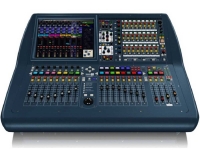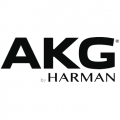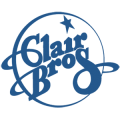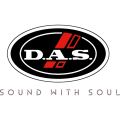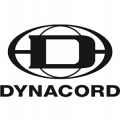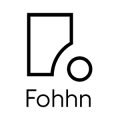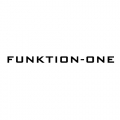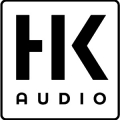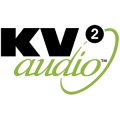ABOUT THE PRODUCT
ABOUT THE MANUFACTURER
GLOSSARY
PRO2C
The Midas PRO2C is designed to work in conjunction with any of the Midas digital I/O units. Each PRO2 Touring Package ships complete with a Midas DL251 stage box,providing 48 Midas mic/line inputs and 16 analogue XLR outputs on stage, in addition to the Midas PRO2C's 8 mic/line inputs and 16 XLR analogue outputs on the back of the console itself. Two AES3 inputs,three AES3 outputs and dual-redundant Power Supplies, all supplied as standard, complete the hardware configuration.
Midas PRO2C is easy to configure and operate and is identical to the PRO2 apart from having 8 fewer input faders.Engineers who are new to Midas digital can relax, enjoy the Midas PRO2C's sample-synchronous audio quality and mix from well within their comfort zone.Engineers already familiar with Midas can just load their existing show file straight into the Midas PRO2C,regardless of which Midas digital console it was created on, and carry on working.
In addition to the Midas PRO2C's 56 primary input channels,Midas PRO2C also features 8 aux returns,all of which feature 4-band Midas parametric EQ and insert points.These 8 aux returns can be used as returns for the Midas PRO2C's internal FX processors or as additional mic channels,if sufficient mic inputs are available on the I/O hardware.
A total of 64 input channels have routing to 27 phase-coherent mix buses,which comprise 16 user-configurable buses (which can be mixes, subgroups or mix minus groups) and 8 matrix buses.The matrix buses source from inputs,as well as groups, and so can be used as 8 additional auxes (monitor mix and FX sends) which provides a total of 24 mixes (plus L, R & Mono) for monitor mixing duties.All buses can be linked as stereo pairs (except the mono bus).
As with all Midas digital consoles,the audio paths can be routed to multiple destinations and the console format can be reconfigured live on a scene-by-scene basis.
Features
- 156 inputs x 166 outputs (max capacity) point-to-point routing anywhere within the Network
- 56 mic/line inputs with Midas mic preamps
- 64 simultaneous input processing channels
- 32 analogue outputs (including 2 stereo local monitor outputs)
- 3 AES3 outputs
- 2 AES3 inputs
- 27 sample-synchronous, phase-coherent mix buses
- 6 multi-channel FX engines
- Up to 28 Klark Teknik DN370 31-band Graphic EQs
- Full-colour 15" daylight-viewable display screen
- 8 VCA (Variable Control Association) groups
- 6 POPulation groups
- 192 MCA (Mix Control Association) groups
- 96kHz 40-bit floating-point processing throughout
DL251
Expand your Midas System
The Midas DL251 is a 5U fixed-configuration I/O unit with 48 mic/line inputs and 16 mic/line outputs. Limited to analogue connections, the DL251 fives you a cost-effective solution if you don`t need the flexibility of Midas modular I/O hardware. You get MIDI in, out and thru - plus one Ethernet control - standard.
Three AES50 ports handle the (n+1) redundant digital audio interface. The DL251 can be switched between 96kHz and 48kHz from the front panel. A rear-panel "mute all outputs" button makes for easy on stage re-patching. The unit is also equipped with dual redundant PSUs.
DL251 I/O Unit Features at a Glance:
- 48 remote control mic/line audio inputs
- 16 audio line outputs fixed configuration
- Switchable between 96kHz and 48kHz sample rates
- Midi out and thru
- Three AES50 ports
- Ethernet control port (using Midas protocols)
- Dual redundant PSUs
- Digital snake and distribution network component
- 5U chassis height
Professional used lighting equipment.| Professional second hand lighting equipment.| Professional pre owned lighting equipment.
Professional used audio equipment.| Professional second hand audio equipment.| Professional pre owned audio equipment.
Second hand audio gear. | Second hand lighting.
Pro audio equipment, second hand amplifiers, DJ, second hand sound systems, second hand Microphones, second hand Media Players.
Outdoor & Indoor LED screens for sale, LED mobile truck.
Light trussing, Gebrauchte Veranstaltungstechnik, used stage equipment Stage & Theatre lighting products.
Used MIDAS Audio
Midas has been designing and manufacturing audio consoles since the early 1970s. Later on it became part of the Telex group. When, in January 2006, Telex Communications was acquired by the Bosch group, Midas consoles became part of the business unit "Bosch Communications Systems". Midas parted company with Bosch in February 2010 and are now part of The Music Group.
A 19-inch rack holding several professional audio devices including a Midas XL88 8×8 matrix mixer at the bottom
A Midas Heritage 3000 mixing console on the right at the Front of House position at an outdoor concert.
Midas consoles are currently being used around the world by audio engineers largely in the live sound realm. Applications for these boards include Front of House (FOH) and monitor console positions.
Common and historical consoles include the Heritage 1000, 2000, 3000 and 4000, the venerable XL4, XL3 and XL200 & 250 large frame professional touring consoles and a variety of less expensive versions aimed at the club and regional sound market.
The first digital console from Midas, the XL8, was launched at the Frankfurt Music Messe in 2006, becoming the flagship Midas console. Notable features include three pre-amps per channel to enable Front of House, Monitor and broadcast control surfaces to be fed from the same input rack, dual redundant master control processors, and integration with the Klark Teknik Helix EQ system via the Rapide remote.
In September 2008 at the annual PLASA tradeshow, Midas introduced the PRO6 Live Audio System, the second networked digital audio system from Midas. Employing technologies developed from the XL8, the PRO6 offers similar audio performance in a compact package. In 2010, the PRO3 and PRO9 digital consoles were added to the Midas product line, along with the VeniceF digital-analog hybrid ("Digi-Log") console, which replaced the Venice analog console.
At the 2011 PLASA show, Midas unveiled the PRO2 and PRO2C consoles, which bring Midas digital features from the larger PRO and XL8 consoles into a more compact package and a lower price point. Midas launched the PRO1 digital console at InfoComm 2012 in Las Vegas. The PRO1 features an even smaller physical footprint and lower price point than the PRO2/PRO2C.
In January 2014 at Winter NAMM in Anaheim, California, MIDAS introduced their newest console, the M32 ($4,999 MSRP in USA), based largely on hugely-successful Behringer X32 mixer, sharing most of OS but with different microphone preamps, same as in MIDAS Pro series mixers. (X32 uses slightly different preamps, also designed by MIDAS, but using a sample rate of 48 kHz, using Cirrus Logic A/D converters.
MIDAS Pro preamps are 96 kHz and use MIDAS' own 8-channel A/D converter, branded MIDAS-8000, which reportedly has better performance numbers than Cirrus Logic chips used by most other console makers).
At that same time, Midas also began retiring much of its analog console product line including the Heritage, Legend, and Siena.
The Verona analog console and VeniceF and VeniceU analog-digital hybrid versions of the original Venice console are still an active part of Midas' product line. Midas also markets the digital audio distribution components that are commonly used with their digital consoles as stand-alone digital snakes, or larger multi-site audio distribution networks.
Linux is used at the core of all Midas digital consoles. This is mentioned prominently in their marketing materials, as well as in their preference for Linux development and kernel programming experience in job postings for development positions. At the core of all MIDAS Pro desks is standard PC motherboard with 4Gb flash card (as OS and data storage).
In December 2009, Midas and Klark Teknik were acquired by Music Group, a holding company chaired by Uli Behringer, which also owns other audio companies such as Turbosound, Behringer and Bugera as well as Electronic Manufacturing Services company Eurotec.
Professional used lighting equipment.| Professional second hand lighting equipment.| Professional pre owned lighting equipment.
Professional used audio equipment.| Professional second hand audio equipment.| Professional pre owned audio equipment.
Second hand audio gear. | Second hand lighting.
Pro audio equipment, second hand amplifiers, DJ, second hand sound systems, second hand Microphones, second hand Media Players.
Outdoor & Indoor LED screens for sale, LED mobile truck.
Light trussing, Gebrauchte Veranstaltungstechnik, used stage equipment Stage & Theatre lighting products.
Octave: The difference between two frequencies where one is twice the other. For example, 200 Hz is an octave higher than 100 Hz. 400 Hz is one octave higher than 200 Hz.
Optical Digital Cable: Fiber optic cable that transfers digital audio signals as light pulses.
Outcue/Outq/Out-Point: These words all refer to the final few seconds of audio signifying the conclusion of the production.
Package: A completed and fully edited audio piece.
Passive: Not active. A passive crossover uses no external power and results in insertion loss. A passive speaker is one without internal amplification.
Phase: Time relationship between signals; it’s all relative.
Power Output: A measure, usually in watts, of how much energy is modulated by a component.
Preamplifier: A control and switching component that may include equalization functions. The preamp comes in the signal chain before the amplifiers.
Pre Outs: Connectors that provide a line-level output of the internal preamp or surround processor.
Pre Outs/Main Ins: Connectors on a receiver that provide an interruptible signal loop between the output of the internal preamp or surround processor portion of the receiver and the input of the amplifier portion of the receiver.
Pre/Pro: A combination preamp and surround processor.
Processors: Anything that processes an incoming signal in some way. Surround processors, for example, can decode a Dolby Digital signal to send to an amp so you can hear it.
Pulse Code Modulation: (PCM) a way to convert sound or analog information to binary information (0s and 1s) by taking samples of the sound and record the resulting number as binary information. Used on all CDs, DVD-Audio, and just about every other digital audio format. It can sometimes be found on DVD-Video.
Q-and-A: Question and answer session.
Receiver: Any component that receives, or tunes, broadcast signals, be it NTSC, HDTV, DBS, or AM/FM radio. Typically refers to the single component that includes a preamp, surround processor, multichannel amplifier, and AM/FM tuner.
Reverberation: The reflections of sound within a closed space.
RF: Radio Frequency. Television signals are modulated onto RF signals and are then demodulated by your television’s tuner. VCRs and DBS receivers often include channel 3 or 4 modulators, allowing the output signal to be tuned by the television on those channels. Also, laser discs used an RF signal for modulating Dolby Digital 5.1 soundtracks on some movies. This requires an RF demodulator (usually referred to as an AC3-RF demodulator) before or in the surround processor to decode the signal.
RMS: Root Mean Square or the square root of the arithmetic mean (average) of the square’s set of values. A reasonably accurate method of describing an amplifier`s power output.
SACD: Super Audio CD. Enhanced audio format with up to six channels of high-resolution audio encoded using DSD. Requires an SACD player. Multichannel also requires a controller with six-channel analog or proprietary digital inputs for full playback.
Sampling Frequency: How often a digital sample is taken of an analog wave. The more samples taken, the more accurate the recording will be. You need to sample at a minimum of twice the highest frequency you want to capture. For example, the 44.1-kilohertz sampling rate of a CD cannot record sounds higher than 22.05 kilohertz.
Scener: A radio report in which the announcer is recorded at the same time and place as the background sound of an event.
Sensitivity: A measurement (in dB) of the sound-pressure level over a specified frequency range created by a speaker driven by 1 watt (2.83V at 8 ohms) of power with a microphone placed 1 meter away.
Signal-to-Noise Ratio: A comparison of the signal level relative to the noise level. Larger numbers are better.
Simultaneous Interpretation: This system allows attendees to hear the meeting in their own language.
Sound Bite: A portion of audio of someone speaking.
Sound field: The total acoustical characteristics of a space, such as ambience number, timing, and relative level of reflections; ratio of direct to reflected sound RT-60 time etc.
Soundstage: The area between two speakers that appears to the listener to be occupied by sonic images. Like a real stage, a soundstage should have width, depth, and height.
Speaker: A component that converts electrical energy into acoustical energy.
SPL: Sound-Pressure Level. Measured in dB.
Subwoofer: A speaker designed to reproduce very low bass frequencies, usually those below about 80 Hz.
THX: Certification program for home theater equipment. Uses some proprietary features, but mostly assures a base quality level for a given room size. (See THX select or Ultra.) Is compatible with any and all soundtrack formats. Stands for either Tom Holman’s eXperiment, after the engineer who drafted the original standard, or is named after the company’s founder George Lucas first movie, THX 1138. Nobody agrees on which.
THX select: Certification program for speakers and receivers that assures a base level of quality and performance when played in a room that’s between 2,000 and 3,000 cubic feet.
User-Generated Content (UGC): Text, photos, video or audio supplied by the customers of a company.
Voicer: A radio report without background audio taken from a scene or otherwise.
Wrap: A radio report containing both the reporter and an actuality.
Professional used lighting equipment.| Professional second hand lighting equipment.| Professional pre owned lighting equipment.
Professional used audio equipment.| Professional second hand audio equipment.| Professional pre owned audio equipment.
Second hand audio gear. | Second hand lighting.
Pro audio equipment, second hand amplifiers, DJ, second hand sound systems, second hand Microphones, second hand Media Players.
Outdoor & Indoor LED screens for sale, LED mobile truck.
Light trussing, Gebrauchte Veranstaltungstechnik, used stage equipment Stage & Theatre lighting products.

